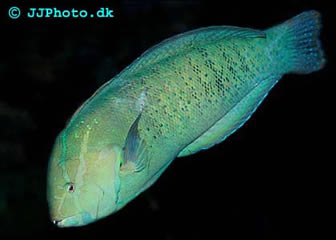Queen Coris
Coris frerei
Common name: Queen Coris, Formosa Coris, Formosa Wrasse, Formosan Coris
Scientific name: Coris formosa
Max size: 24 in / 60 cm (some reports say 33 in / 86 cm)
pH: 8.1-8.4
Salinity: 1.020-1.025
Temperature: 72-78ºF (22-26°C)
The Queen coris is a wrasse that grows very big and it is recommended for advanced saltwater aquarists only. It is rather sensitive and requires a large aquarium.
Adult and juvenile specimens differ a lot in appearance from each other. Juvenile specimens are yellowish brown with black fins. Adult specimens have a solid blue green body. As they develop, they display a lot of different colorations before ending up with the adult coloration and semi-adult specimens can often be quite stunning.
The Queen coris originates from the western part of the Indian Ocean where they can be found from the southern Red Sea in the north to South Africa in the south, and eastwards to Sri Lanka.
They are aggressive and should only be kept with other similarly sized aggressive fish. They are not reef safe because they will eat just about anything that fits into their mouths.
Queen coris care and aquarium setup:
If you want to keep the Queen coris you will need a very large aquarium. 185 gallon / 700 L is considered a minimum and I recommend an aquarium of at least twice, preferably three times, that size if you are going to house an adult specimen. Don't buy this species if you can't house it as an adult. They should never be kept in a reef aquarium as they are definitely not reef safe. Decorate the aquarium with a rocky bottom and a few hiding places that are large enough for your Queen coris. Keep the water quality high and stable and the water well circulated.
Ideal water conditions for the Queen coris wrasse are pH 8.1-8.3, salinity 1.020-1.025, and temperature 74-78ºF (23-26°C).
Feeding Queen coris
They are as earlier mentioned carnivores and should as such be fed a varied high protein diet. They can sometimes be trained to accept marine flake food. The Queen coris can be fed a variety of different sea food and frozen food. A varied diet of clams, shrimps, crab meat and chopped fish as well as some vitamin enriched flake food (if they accept it) is recommended. Feed 2-3 times a day when young and 1-2 times a day as adults.
Breeding Queen coris
We have no info on breeding the Queen coris, but it is safe to assume that breeding this large and aggressive species would require a gigantic aquarium and perfect water conditions.
Wrasse Articles:
Bird Wrasse – Gomphosus varius
Dragon Wrasse - Novaculichthys taeniourus
Harliquin Tuskfish – Coerodon fasciatus
Hogfish - Information about Hogfish
Neon Wrasse – Halichoeres melanurus
Ornate Wrasse – Halichoeres ornatissimus
Radient Wrasse – Halichoeres iridis
Spanish Hogfish – Bodianus rufus
Striated Wrasse – Pseudocheilinus evanidus
Yellow Coris – Halichoeres chrysus
Line Wrasses:
Fourline Wrasse – Pseudocheilinus tetrataenia
Sixline Wrasse – Pseudocheilinus hexataenia
Eightline Wrasse – Pseudocheilinus octotaenia
Fairy Wrasses:
Exquisite Fairy Wrasse – Cirrhilabrus exquisitus
Lubbock's Fairy Wrasse – Cirrhilabrus lubbocki
Scott's Fairy Wrasse – Cirrhilabrus scottorum
Solar Fairy Wrasse – Cirrhilabrus solorensis
Flasher Wrasses:
Carpenter's Flasher Wrasse – Paracheilinus carpenteri
Dot-and-Dash Flasher Wrasse – Paracheilinus lineopunctatus
Filamented Flasher Wrasse – Paracheilinus filamentosus
McCosker's Flasher Wrasse – Paracheilinus mccoskeri

